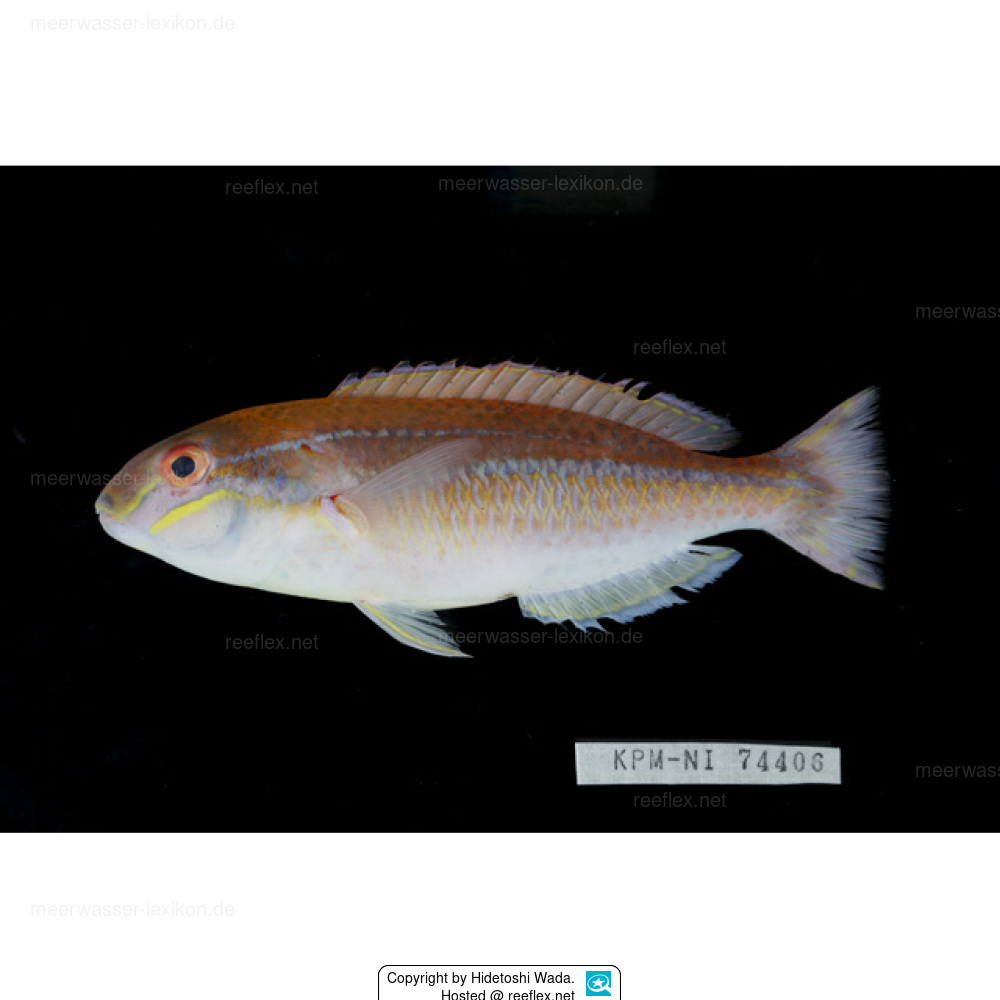Info
Choerodon japonicus is a reddish-orange toothy wrasse that becomes lighter below a pearly blue median stripe that runs from the upper jaw over the eye to the base of the caudal fin.
Males in the terminal phase are greenish with a second, narrower stripe that starts behind the eye and runs along the lateral line to the top of the caudal fin peduncle.
The upper side of the body is red to green, the underside white with a pearl-blue central stripe that runs diagonally from the underside of the eye to the base of the caudal fin and is deflected downwards below the eye to the upper jaw;
The species name "albofasciatus" (former name Choerodon albofasciatus) comes from the Latin, "albo" meaning "white" and "fasciatus" meaning "envelope with bands", and refers to the conspicuous white stripe on the side as part of the initial phase coloration of this species.
Parenti & Randall (2018) consider that C. albofasciatus is an unneeded replacement name for Choerodonoides japonicus ,
see A checklist of wrasses (Labridae) and parrotfishes (Scaridae) of the world: 2017 update
https://coralreeffish.com/OSFweb/josf/josf30b.pdf
Depth distribution data : CSIRO National Collections and Marine Infrastructure 40 - 200 meters.
Etymology:
Name from the Latin 'albo' meaning white and 'fasciatus' meaning 'shell with bands', referring to the distinctive white stripe on the side as part of the initial coloration of this species
We would like to thank Dr. Hidetoshi Wada from the Kanagawa Prefectural Museum of Natural History in Japan for the first photo of Decodon pacificus!
Synonyms:
Choerodon albofasciatus Gomon, 2017
Choerodonoides japonicus Kamohara, 1958
Pealopesia gymnogenys
Males in the terminal phase are greenish with a second, narrower stripe that starts behind the eye and runs along the lateral line to the top of the caudal fin peduncle.
The upper side of the body is red to green, the underside white with a pearl-blue central stripe that runs diagonally from the underside of the eye to the base of the caudal fin and is deflected downwards below the eye to the upper jaw;
The species name "albofasciatus" (former name Choerodon albofasciatus) comes from the Latin, "albo" meaning "white" and "fasciatus" meaning "envelope with bands", and refers to the conspicuous white stripe on the side as part of the initial phase coloration of this species.
Parenti & Randall (2018) consider that C. albofasciatus is an unneeded replacement name for Choerodonoides japonicus ,
see A checklist of wrasses (Labridae) and parrotfishes (Scaridae) of the world: 2017 update
https://coralreeffish.com/OSFweb/josf/josf30b.pdf
Depth distribution data : CSIRO National Collections and Marine Infrastructure 40 - 200 meters.
Etymology:
Name from the Latin 'albo' meaning white and 'fasciatus' meaning 'shell with bands', referring to the distinctive white stripe on the side as part of the initial coloration of this species
We would like to thank Dr. Hidetoshi Wada from the Kanagawa Prefectural Museum of Natural History in Japan for the first photo of Decodon pacificus!
Synonyms:
Choerodon albofasciatus Gomon, 2017
Choerodonoides japonicus Kamohara, 1958
Pealopesia gymnogenys







 Dr. Hidetoshi Wada, Japan
Dr. Hidetoshi Wada, Japan






















